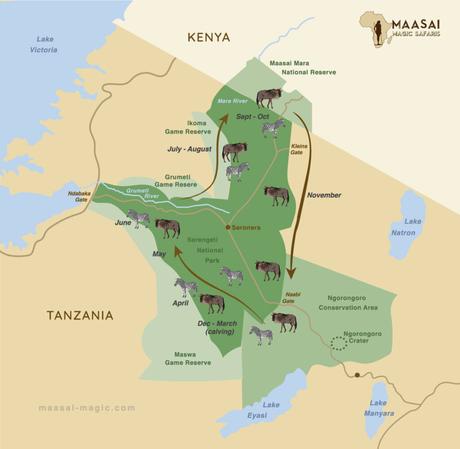A Safari to Serengeti is not complete without spending some time to witness the great migration. Do you know when is the Best Time To See the Great Wildebeest Migration? If you know, then you are good to go, if not, keep reading this article to the end.
What is the Great Wildebeest Migration?
Before we start talking about the Best Time To See The Great Wildebeest Migration, it’s better to know what it is and what is so special about it.
The Great Wildebeest Migration is simply a mass movement of animals between the Southern Plains of Serengeti in Tanzania and Masai Mara in Kenya, in search of greener pasture and water. These animals move freely between the two countries regardless of the national boundaries. This has happened for so many years of their existence on earth, on an evolutionary timescale.
Animals involved in this large-scale movement are millions of Wildebeests, thousands of Zebras, and hundreds of other animals like Thompson’s Gazelles, Elands and more.
It is the magnitude of the sheer number of Wildebeests amassed in the migratory herds that grant the name of their evolutionary movement as ‘The Great Wildebeest Migration’ or ‘The Great Serengeti Migration’.
What is so special about the Great Wildebeest Migration?
This is one of the greatest spectacles in the natural world that involves thousands and thousands of animals. It is this migration that many people envisage when they think of ‘Wild Africa’, an impressive pilgrimage of 1000 plus miles across the two countries, in a Greater Serengeti ecosystem.
It is extremely fascinating to see and hear thousands of bulls in a Big Hum, advertising themselves profoundly to pass on their genes. Thousands of babies are born every single day during the calving season.
In the course, predators such as Lions, Leopards, Cheetahs, Hyenas, and Jackals are also attracted to the scene of the migration, while Vultures circle overhead to clean up. Some of Africa’s biggest crocodiles lie in wait, with price tags for any river crossing by the migratory beasts.
No doubt that this incredible event on the planet earth has made the ‘Great Serengeti Migration’ to qualify amongst the Seven Natural Wonders of Africa. Other Wonders in the list are Ngorongoro Crater, Mount Kilimanjaro, The Nile River, The Great Sea Reef, Sahara Desert and The Okavango Delta.
The Great Migration: Month by Month
Herds of the Great Migration are always on the move in a cycle all year round. Here is the distribution of the migratory animals to enable better planning of your African Safari.

January: Southern Serengeti
This month, herds move to the Southern parts of Serengeti National Park where there is pretty fresh green grass caused by rainfalls in November and December. Predators also know this schedule!
February: Calving in Southern Serengeti
Ndutu is known as a place where Wildebeests give birth-it is their ‘Calving Ground’. Wildebeest prefer to give birth in this area because of the new fresh grasses and open landscapes. They also prefer to give birth in this area because it is easy for them to see predators. Up to 500,000 baby Wildebeests are born in this area annually.
March: Movement on the Plains
This time, baby Wildebeests have grown stronger and, it will be approaching the end of Baby Boom Season in Ndutu area. Herds start moving across the Southern Plains, in search of fresh grass towards Central Serengeti.
Predators also follow the movement as this is another best opportunity for getting an easy prey.
April: South to Central Serengeti
In the month of April, the migratory animals keep moving towards Central Serengeti, in search of green grass and water. During this movement, they leave almost completely barren landscape.
May: Central to Western Serengeti
Here the migratory animals continue to move towards Western Serengeti, crossing both Mbalageti and Grumeti rivers. This is where survival of the fittest also happens, on the way to Masai Mara National Reserve, a new land with fresh pasture.
June to July: Western Serengeti to North
This time around, the migratory beasts slowly leave the Western parts of Serengeti towards North, across Ikorongo Game Reserve, and spread out to cover the Northern parts of Serengeti.
August, September, October: Northern Serengeti / Mara
During this time there are highest concentrations of Wildebeests, Zebras, and Gazelles along Mara river, presenting annual feast to the predatory Nile Crocodiles, the feast they have waited for almost a year.
November: The Journey Back to the Plains
In November, most of the herds start their movement back to the Southern Serengeti either through the Eastern Serengeti (across Loliondo and Lobo areas) or the Western Serengeti. The speed and direction of migration will be determined by thunderstorms and rainfall patterns in the park.
December
Herds are expected to arrive in the Southern Serengeti. If rainfall delay in these areas, then herds will choose to stay along permanent water sources elsewhere in the park.
So when is the best time to see the Great Wildebeest Migration?
This depends on your interests. June, July, August, September and October could be the best options to experience the highest populations of the migratory animals crossing rivers. If you prefer to experience babies born, January, February and March could be the perfect months to add on your list. In April, May and December, the migratory animals will still be on the move to get to greener parts of the park.
Take note: The Great Wildebeest Migration is a natural event, don’t expect the cycle to happen the same way every year. Weather has a large influence on their movement and herds will respond to such changes accordingly and follow the rains or concentrate on permanent water sources.
